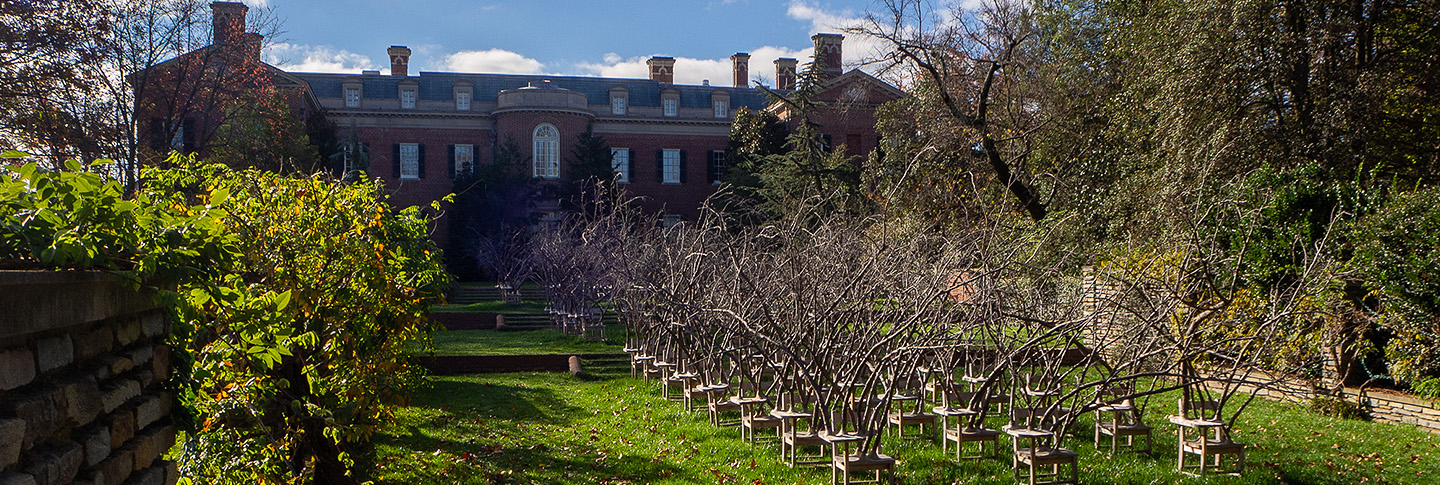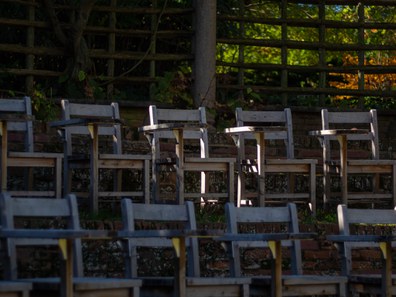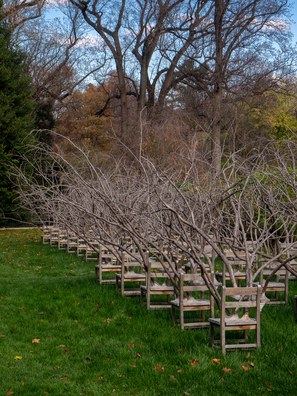
Hugh Hayden
Brier Patch, October 2022-September 25, 2023
Dumbarton Oaks is honored to host an acclaimed installation by artist Hugh Hayden, first exhibited in Madison Square Park, New York. Titled Brier Patch, it features one hundred wooden elementary-school-style desks distributed in several groupings throughout the garden. Seventy-five of them erupt with tree branches, cohering into tangled assemblages with complex and shifting meanings.
 “In material and spatial terms, Brier Patch could not be more suited to its settings at Dumbarton Oaks. Its white cedar branches call out to the garden’s trees, especially in winter. Its proportions—height and width—are precisely suited to the spaces where it is installed: the chairs without branches in the amphitheater, where the configuration resembles a lecture hall; those with branches in a grid on the North Vista, where it suggests a series of classrooms. The latter group takes advantage of the terracing and the narrowing, lengthening geometries of the space: five rows of five chairs on the first terrace, five rows of four on the second, and eight rows of three on the lowest. The collective effect exaggerates the sense of distance already apparent on the North Vista.“In material and spatial terms, Brier Patch could not be more suited to its settings at Dumbarton Oaks. Its white cedar branches call out to the garden’s trees, especially in winter. Its proportions—height and width—are precisely suited to the spaces where it is installed: the chairs without branches in the amphitheater, where the configuration resembles a lecture hall; those with branches in a grid on the North Vista, where it suggests a series of classrooms. The latter group takes advantage of the terracing and the narrowing, lengthening geometries of the space: five rows of five chairs on the first terrace, five rows of four on the second, and eight rows of three on the lowest. The collective effect exaggerates the sense of distance already apparent on the North Vista.
“In material and spatial terms, Brier Patch could not be more suited to its settings at Dumbarton Oaks. Its white cedar branches call out to the garden’s trees, especially in winter. Its proportions—height and width—are precisely suited to the spaces where it is installed: the chairs without branches in the amphitheater, where the configuration resembles a lecture hall; those with branches in a grid on the North Vista, where it suggests a series of classrooms. The latter group takes advantage of the terracing and the narrowing, lengthening geometries of the space: five rows of five chairs on the first terrace, five rows of four on the second, and eight rows of three on the lowest. The collective effect exaggerates the sense of distance already apparent on the North Vista.“In material and spatial terms, Brier Patch could not be more suited to its settings at Dumbarton Oaks. Its white cedar branches call out to the garden’s trees, especially in winter. Its proportions—height and width—are precisely suited to the spaces where it is installed: the chairs without branches in the amphitheater, where the configuration resembles a lecture hall; those with branches in a grid on the North Vista, where it suggests a series of classrooms. The latter group takes advantage of the terracing and the narrowing, lengthening geometries of the space: five rows of five chairs on the first terrace, five rows of four on the second, and eight rows of three on the lowest. The collective effect exaggerates the sense of distance already apparent on the North Vista.
 On a more conceptual level, Brier Patch’s ambivalent messages about the challenges and opportunities of education take on particular relevance in the context of an academic institution like Dumbarton Oaks. The sculpture’s evocation of trickster tales rooted in African and Native American cultures might seem to challenge the more elitist narratives associated with the history of the institution, especially Mediterranean cultural traditions. At the very least, the piece argues for a more inclusive conception of the humanities. Moreover, the fact that the chairs face away from the house suggests a turning away from what the institution represents. To be sure, questions of equal opportunity and access to education resonate in a garden that is only open to the public at certain times and that is a resource of a university very publicly struggling with legal and ethical issues of equity and diversity. But in Hayden’s mind, the relationship is more ambiguous. The piece shares with the house the view out over the North Vista; the artist says Brier Patch in this setting is as much about “learning from the institution” as it is about reflecting upon its past. He says he was particularly inspired by the institution’s emphasis on learning from nature, an idea underscored by the sequence from house to garden to the woodland beyond, a sequence in which Brier Patch takes a subtly eloquent position.”
On a more conceptual level, Brier Patch’s ambivalent messages about the challenges and opportunities of education take on particular relevance in the context of an academic institution like Dumbarton Oaks. The sculpture’s evocation of trickster tales rooted in African and Native American cultures might seem to challenge the more elitist narratives associated with the history of the institution, especially Mediterranean cultural traditions. At the very least, the piece argues for a more inclusive conception of the humanities. Moreover, the fact that the chairs face away from the house suggests a turning away from what the institution represents. To be sure, questions of equal opportunity and access to education resonate in a garden that is only open to the public at certain times and that is a resource of a university very publicly struggling with legal and ethical issues of equity and diversity. But in Hayden’s mind, the relationship is more ambiguous. The piece shares with the house the view out over the North Vista; the artist says Brier Patch in this setting is as much about “learning from the institution” as it is about reflecting upon its past. He says he was particularly inspired by the institution’s emphasis on learning from nature, an idea underscored by the sequence from house to garden to the woodland beyond, a sequence in which Brier Patch takes a subtly eloquent position.”
― John Beardsley
Consulting Curator
About the Artist
Hugh Hayden was born in Dallas, Texas in 1983 and lives and works in New York City. He holds a Bachelor of Architecture from Cornell University and an MFA from Columbia University. His work, he says, arises from a deep connection to nature and organic materials along with a youthful passion for gardening at his family’s home. He often explores commonplace objects as varied as discarded tree trunks, Christmas trees, cooking pans, or souvenir African sculptures; he saws, weaves, sculpts, and sands the material, creating works that express inherent cultural histories. He has had solo exhibitions at the Institute of Contemporary Art, Miami (2022); Princeton University Art Museum (2020); and White Columns, New York (2018).
Press
- "In the Galleries: Installation has Lessons on Education, Inclusivity" (Washington Post, July 14, 2023)
- "Dumbarton Oaks’ ‘Brier Patch’ Explores Education, Nature, Equality" (The Georgetowner, January 26, 2023)
- Mention in "Best Things to Do in the DC Area 1/26-1/29" (Washingtonian, January 26, 2023)
Acknowledgements
Hugh Hayden’s Brier Patch was commissioned by Madison Square Park Conservancy, New York, and was first exhibited in Madison Square Park.
Photographs: Kevin McDonald